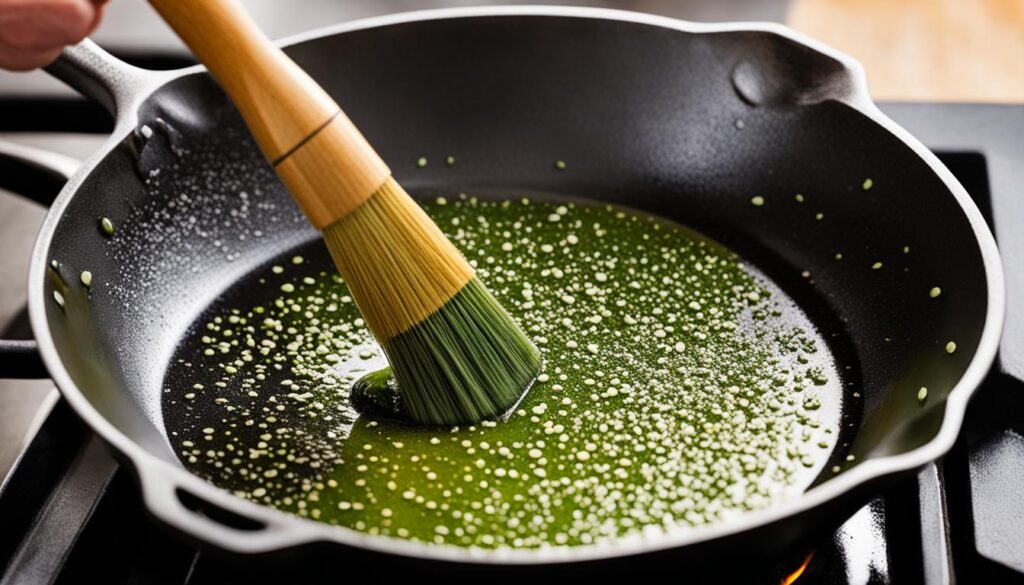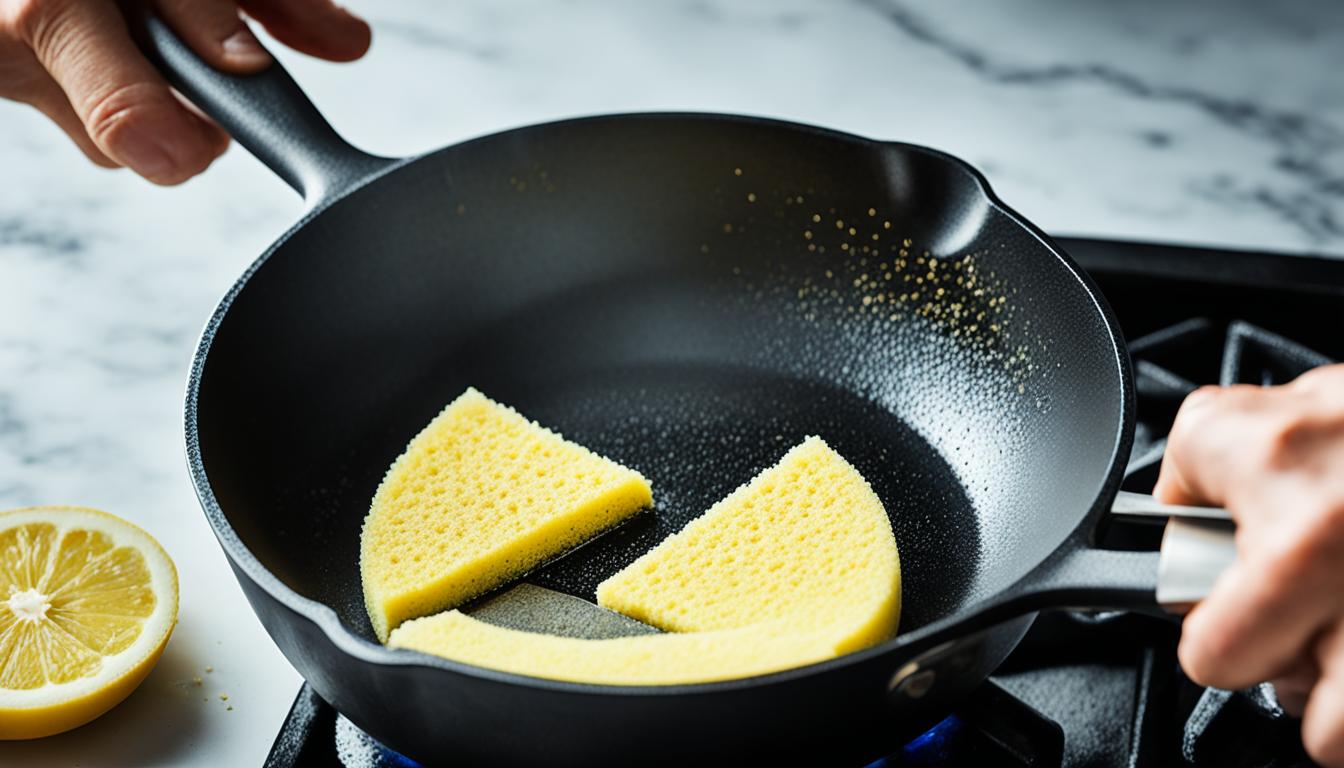Welcome to our comprehensive guide on cast iron care tips. Here, we will share expert advice on how to clean, maintain, and properly care for your cast iron pan, skillet, and cookware. Whether you’re a seasoned cast iron enthusiast or just starting out, our tips and techniques will help you ensure the longevity of your beloved cast iron pots and pans.
Proper cleaning techniques for cast iron pans are often misunderstood, but fear not, we’re here to debunk the myths. Contrary to popular belief, you can use soap to clean your cast iron skillet without ruining the seasoning. We’ll explain the best cleaning practices and address some common concerns, such as how to remove tough stains and deal with rust.
Caring for your cast iron skillet goes beyond just cleaning. Regular maintenance is key to keeping it in top condition and ensuring its longevity. From seasoning your skillet to storing it properly, we’ll cover all aspects of maintaining your cast iron cookware.
So, whether you’re a pro in the kitchen or a novice cook, join us as we delve into the world of cast iron care. Get ready to unlock the secrets of cleaning and maintaining your cast iron skillet, so you can enjoy delicious meals for years to come.
Seasoning Your Cast Iron Skillet: The Essential Step
Seasoning is a crucial step in maintaining cast iron cookware. It creates a protective layer that prevents rust and enhances the non-stick properties of the skillet.
To season your cast iron skillet, follow these steps:
- Thoroughly wash the skillet with hot, soapy water.
- Dry the skillet completely with a clean towel.
- Apply a thin layer of vegetable oil or another high-smoke-point oil to the inside and outside of the skillet.
- Use a paper towel or cloth to wipe away any excess oil.
- Place the skillet upside down in a preheated oven at 450 degrees Fahrenheit (232 degrees Celsius) for 30 minutes.
- Repeat this process several times to build up a strong seasoning.
Proper seasoning is especially important if your skillet becomes rusty. To restore a rusty cast iron skillet:
- Scrub off the rust with a scrub brush or steel wool.
- Follow the seasoning steps mentioned earlier, starting from thoroughly washing the skillet.
- Once the skillet is reseasoned, make sure to use it regularly to maintain its seasoning.

Cleaning Your Cast Iron Skillet: Debunking the Myths
Contrary to popular myths, you can use soap to clean your cast iron skillet without ruining the seasoning. Gentle dish soap and warm water are sufficient for removing grease and food residue. Use a non-scratch sponge or a nylon scrubbing brush to clean the skillet, avoiding harsh abrasives like steel wool.
If there are stubborn bits, you can use salt as a mild abrasive. Sprinkle salt on the skillet and scrub gently using a damp cloth or sponge. The salt helps to lift off any remaining residue while preserving the seasoning on the surface.
After cleaning, make sure to dry the skillet thoroughly to prevent rust formation. Moisture is the enemy of cast iron, so wipe the skillet with a clean towel or place it on low heat for a few minutes to evaporate any remaining moisture.
Proper Cleaning Techniques for Cast Iron Pans
“Cleaning cast iron with salt not only helps to remove stubborn residue, but also acts as a gentle scrub without damaging the seasoning.”
Here are some essential cleaning techniques to keep in mind:
- Wait until the skillet has cooled down before cleaning to avoid warping or cracking.
- Use a gentle dish soap and warm water to remove grease and food residue. Avoid using abrasive cleaners that can strip or damage the seasoning.
- For stubborn bits, sprinkle salt on the skillet and scrub with a damp cloth or sponge. The salt acts as a mild abrasive without harming the surface.
- Rinse the skillet thoroughly with warm water to remove any soap or salt residue.
- Dry the skillet completely with a clean towel or by placing it on low heat to evaporate any remaining moisture.
“Cleaning cast iron pans with salt is a safe and effective method, ensuring your skillet remains in optimal condition for years to come.”
With these proper cleaning techniques, you can confidently maintain your cast iron skillet without worrying about damaging the seasoning or compromising its performance. By debunking the myths surrounding cast iron care, you can enjoy the benefits of cooking with this durable and versatile cookware for generations.

| Myth | Reality |
|---|---|
| You can’t use soap to clean cast iron. | Gentle soap is safe and effective for cleaning cast iron. |
| Cleaning with salt ruins the seasoning. | Salt can be used as a mild abrasive to remove stubborn residue without harming the seasoning. |
| Only use water to clean cast iron. | Soap and water can effectively remove grease and food residue. |
| Harsh abrasives like steel wool are required for cleaning. | A non-scratch sponge or nylon scrub brush is sufficient for cleaning cast iron. |
Regular Maintenance: The Key to Longevity
Regular maintenance is essential for keeping your cast iron skillet in top condition. By following these simple steps, you can ensure that your skillet remains a cherished part of your culinary arsenal for years to come.
- After each use, wash your skillet with soap and warm water, making sure to remove any food particles.
- Dry the skillet completely to prevent the formation of rust. Moisture is the enemy of cast iron, so be thorough in your drying process.
- To further maintain the seasoning on your skillet, lightly coat it with cooking oil. This will help replenish the protective layer and enhance its non-stick properties.
- Heat the oiled skillet over a burner for a few minutes to allow the oil to penetrate and bond with the iron surface.
- When storing your cast iron skillet, choose a dry place such as an oven or cupboard. Avoid storing it in a damp environment, as this can lead to moisture buildup and rust.
Maintaining your cast iron pots and pans requires just a few minutes of your time, but the rewards are well worth the effort. With proper care, your skillet will develop a beautiful patina and become even more versatile in the kitchen.
Remember, a well-maintained cast iron skillet is a culinary heirloom that can be passed down through generations. By following these maintenance tips, you can preserve its quality and enjoy its exceptional cooking performance for years to come.
Special Situations: Dealing with Tough Stains and Rust
In special situations like dealing with tough stains or rust, there are specific techniques you can use to restore your cast iron skillet. It’s important to address these issues promptly to ensure the longevity of your skillet.
Removing Stubborn Stains:
- Create a paste by mixing baking soda and water.
- Apply the paste to the affected area.
- Scrub the stained area gently using a non-scratch sponge or nylon scrubbing brush.
- Rinse the skillet thoroughly with warm water.
- Dry the skillet completely.
Restoring Rusted Cast Iron:
- Mix equal parts vinegar and water in a container.
- Submerge the rusted portion of the skillet in the vinegar-water mixture.
- Allow it to soak for a few hours or overnight.
- Remove the skillet from the mixture and scrub off the rust using a non-scratch sponge or nylon scrubbing brush.
- Rinse the skillet thoroughly with warm water.
- Dry the skillet completely.
- Reapply seasoning by following the steps in the previous section.
By following these techniques, you can effectively remove tough stains and rust from your cast iron cookware, restoring it to its former glory.
Troubleshooting: Common Concerns and Solutions
While caring for your cast iron skillet is relatively simple, it’s not uncommon to encounter some common issues along the way. Don’t worry, we’ve got you covered. Here are a few troubleshooting tips to help you address these concerns:
If you accidentally strip the seasoning off your skillet, it’s not the end of the world. Simply reseasoning your skillet can bring it back to life. Start by thoroughly cleaning the skillet with warm water and gentle dish soap. Rinse and dry it completely. Then, apply a thin layer of vegetable oil or melted shortening to the entire surface, inside and out. Place the skillet upside down in a preheated oven at 350°F for an hour and let it cool. This process will create a new protective seasoning layer.
If your skillet develops sticky residue or food starts to stick, it may be time for a deep clean and reseasoning. Begin by scrubbing the skillet with warm water and gentle dish soap, using a non-scratch sponge or nylon scrubbing brush. Rinse it thoroughly and dry completely. Once the skillet is dry, apply a thin layer of oil and heat it over medium heat until it starts to smoke. Let it cool, and your skillet will be ready to use again.
And remember, if you still have any lingering questions or need further assistance with your cast iron care, our friendly Customer Care Associates are here to help. Don’t hesitate to reach out to us for guidance and support. We’re dedicated to ensuring that your cast iron skillet lasts for generations to come!
